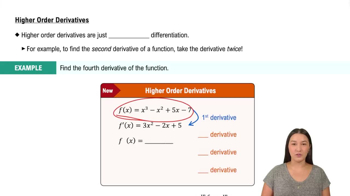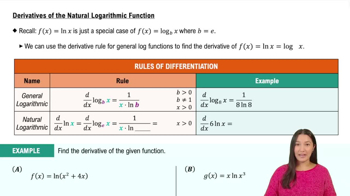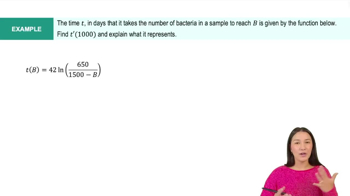Table of contents
- 0. Functions7h 52m
- Introduction to Functions16m
- Piecewise Functions10m
- Properties of Functions9m
- Common Functions1h 8m
- Transformations5m
- Combining Functions27m
- Exponent rules32m
- Exponential Functions28m
- Logarithmic Functions24m
- Properties of Logarithms34m
- Exponential & Logarithmic Equations35m
- Introduction to Trigonometric Functions38m
- Graphs of Trigonometric Functions44m
- Trigonometric Identities47m
- Inverse Trigonometric Functions48m
- 1. Limits and Continuity2h 2m
- 2. Intro to Derivatives1h 33m
- 3. Techniques of Differentiation3h 18m
- 4. Applications of Derivatives2h 38m
- 5. Graphical Applications of Derivatives6h 2m
- 6. Derivatives of Inverse, Exponential, & Logarithmic Functions2h 37m
- 7. Antiderivatives & Indefinite Integrals1h 26m
- 8. Definite Integrals4h 44m
- 9. Graphical Applications of Integrals2h 27m
- 10. Physics Applications of Integrals 2h 22m
6. Derivatives of Inverse, Exponential, & Logarithmic Functions
Derivatives of Exponential & Logarithmic Functions
Problem 3.9.88
Textbook Question
Find the following higher-order derivatives.
d²/dx² (In(x² + 1))
 Verified video answer for a similar problem:
Verified video answer for a similar problem:This video solution was recommended by our tutors as helpful for the problem above
Video duration:
6mPlay a video:
Was this helpful?
Key Concepts
Here are the essential concepts you must grasp in order to answer the question correctly.
Higher-Order Derivatives
Higher-order derivatives refer to the derivatives of a function taken multiple times. The first derivative gives the rate of change of the function, the second derivative provides information about the curvature or concavity, and so on. In this context, finding the second derivative involves differentiating the function twice with respect to the variable.
Recommended video:

Higher Order Derivatives
Chain Rule
The chain rule is a fundamental differentiation technique used when differentiating composite functions. It states that the derivative of a composite function is the derivative of the outer function evaluated at the inner function, multiplied by the derivative of the inner function. This rule is essential for correctly differentiating functions like In(x² + 1), where x² + 1 is the inner function.
Recommended video:

Intro to the Chain Rule
Natural Logarithm Function
The natural logarithm function, denoted as In(x), is the logarithm to the base e, where e is approximately 2.71828. It is important in calculus because it has unique properties, such as its derivative being 1/x. Understanding how to differentiate the natural logarithm, especially in the context of composite functions, is crucial for solving the given problem.
Recommended video:

Derivative of the Natural Logarithmic Function

 4:50m
4:50mWatch next
Master Derivatives of General Exponential Functions with a bite sized video explanation from Callie
Start learningRelated Videos
Related Practice













